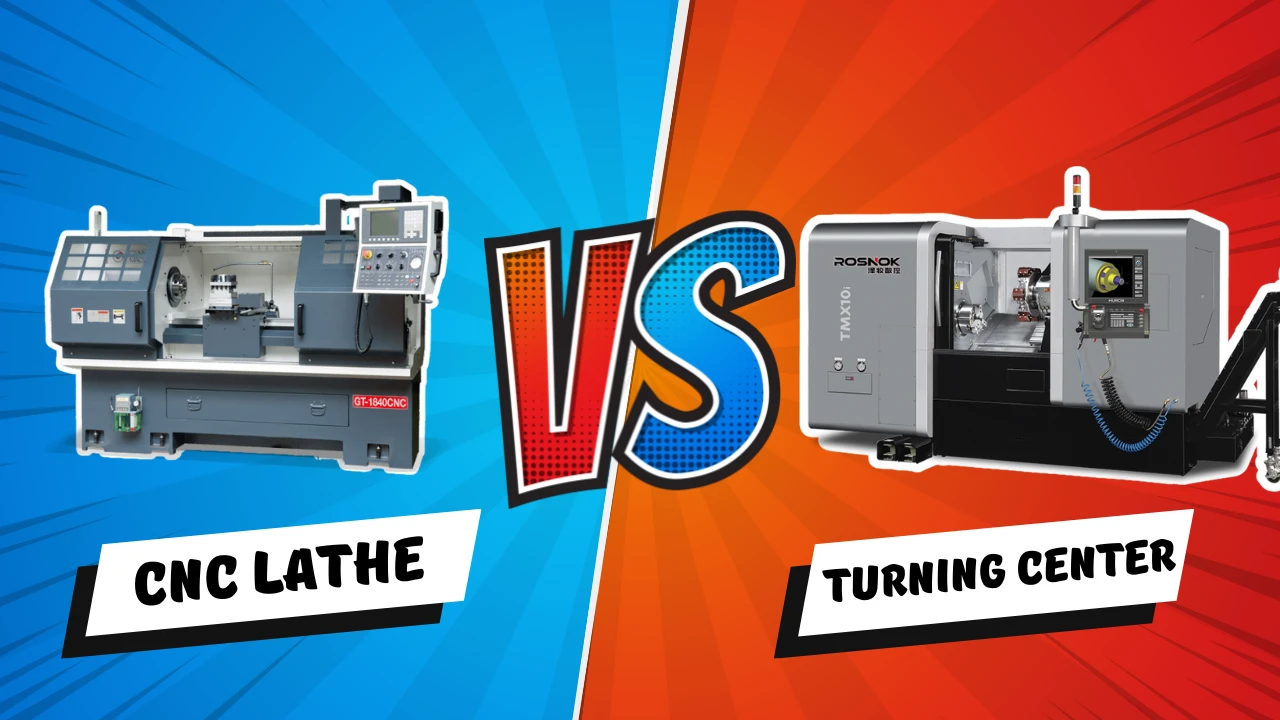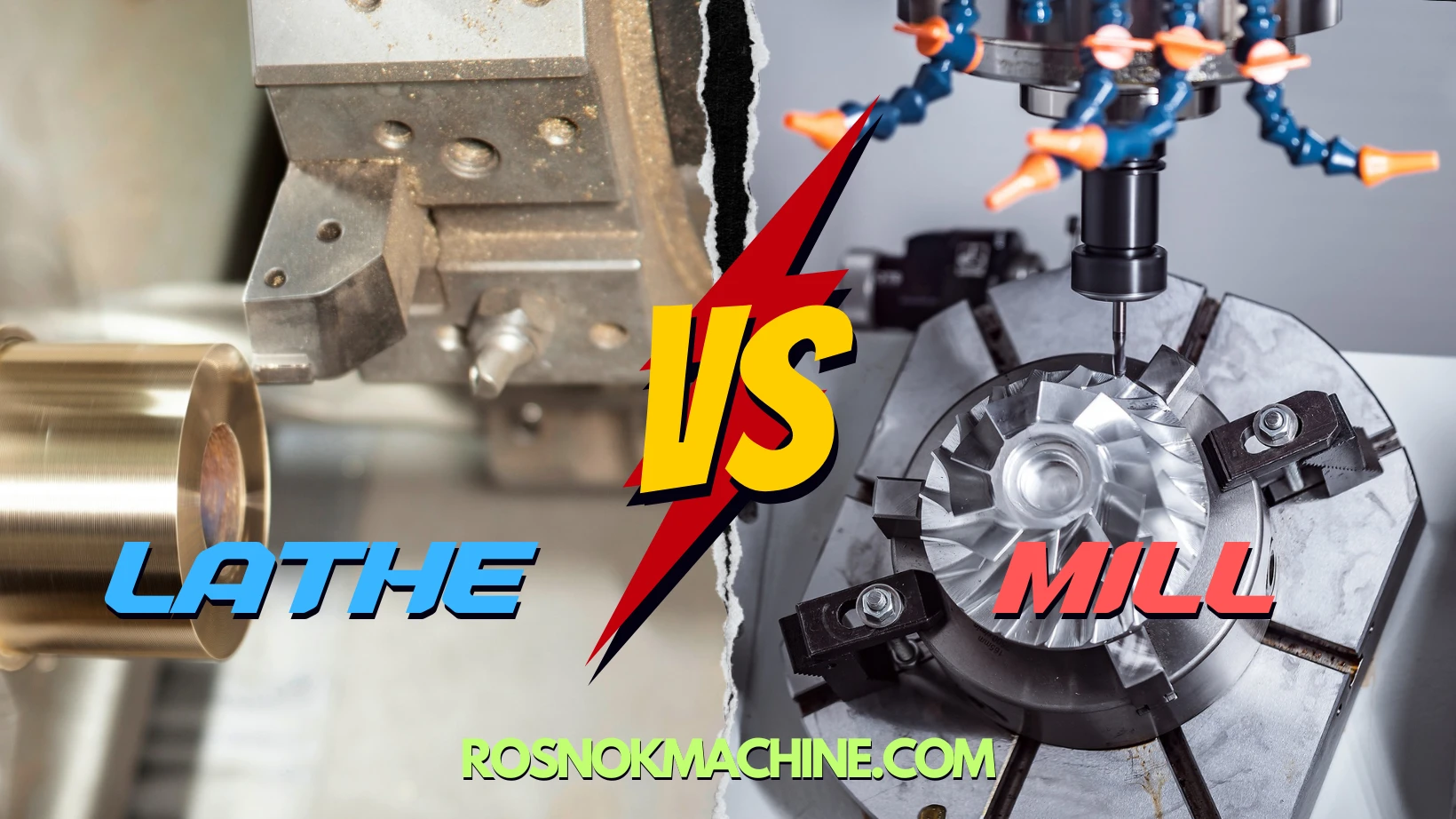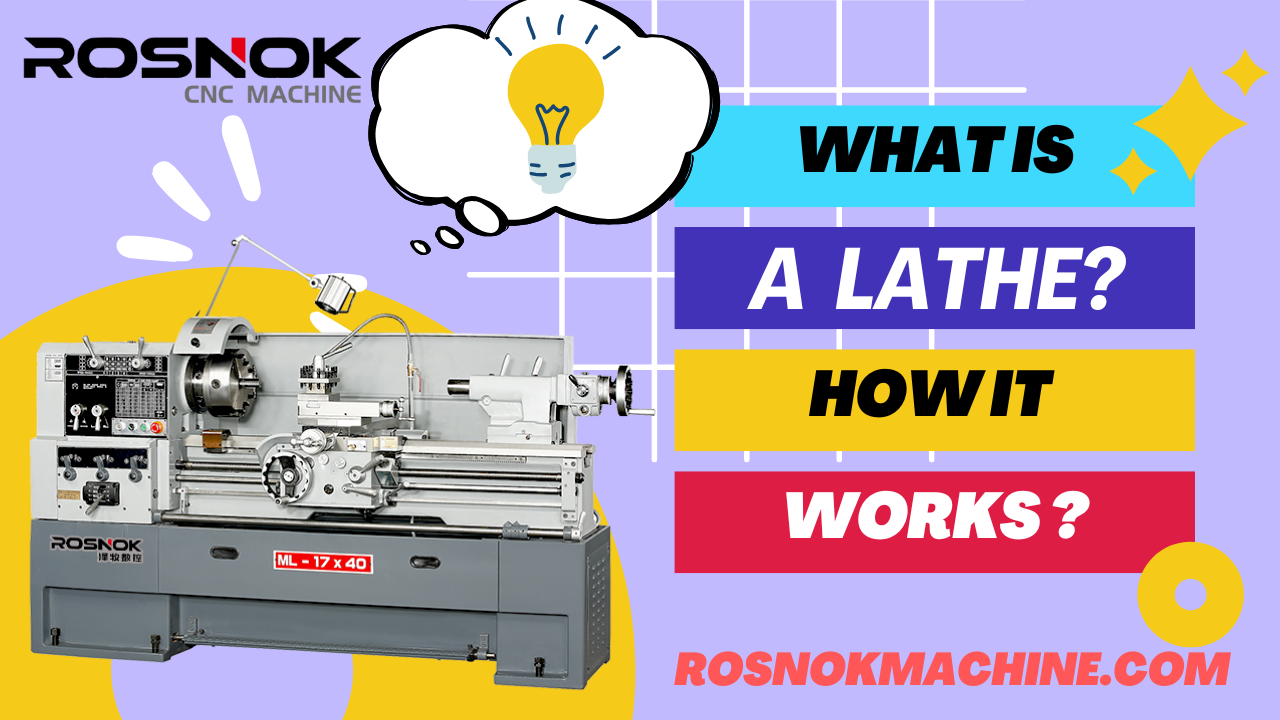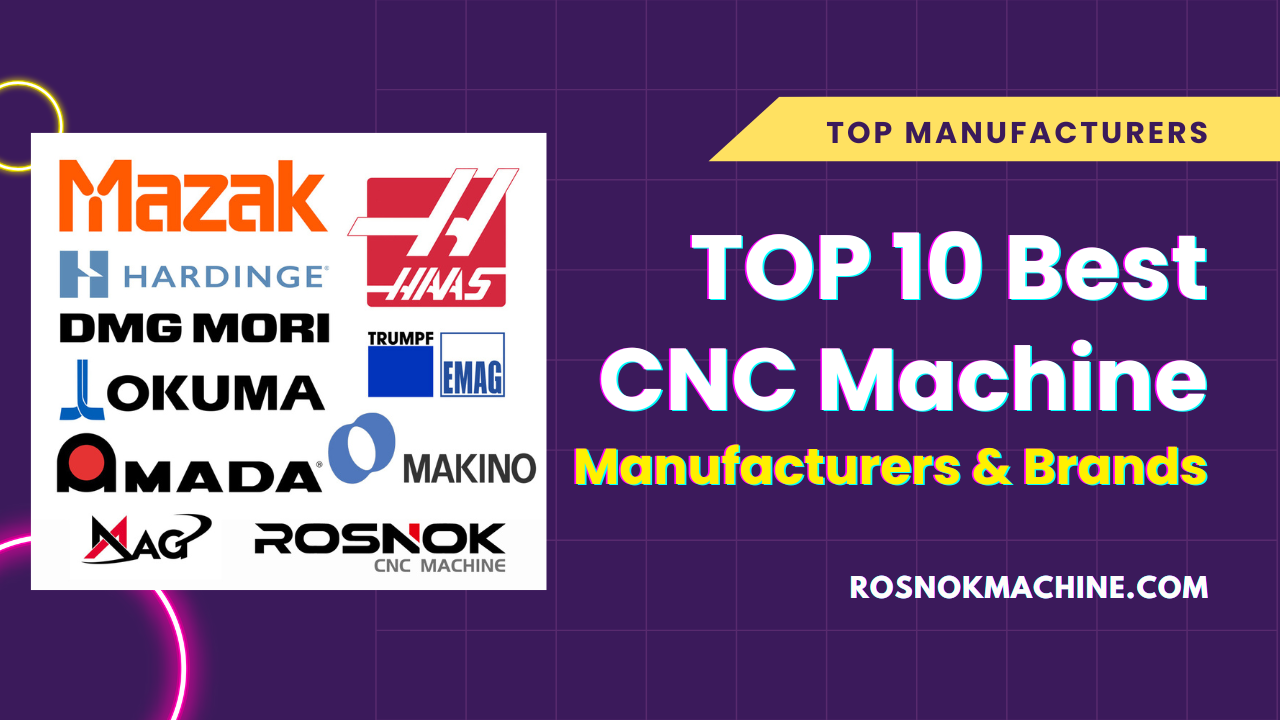Have you ever wondered what truly sets a CNC Lathe vs Turning Center apart? Is it their structure, their working principles, or their machining capabilities? Do they differ in accuracy, automation, or versatility? Which machine excels in complex operations, and which achieves faster, more efficient production in modern manufacturing?
A CNC lathe is a two-axis machine optimized for turning operations, producing precise cylindrical or conical parts through controlled cutting along the X and Z axes. A turning center builds on this foundation, adding features like live tooling, a Y-axis, sub-spindles, and automatic tool changers, enabling milling, drilling, and multi-surface machining in one setup. This integration reduces setups, improves geometric accuracy, and expands the complexity of parts that can be produced, making turning centers far more versatile for modern manufacturing demands.
Continue reading this article to learn the differences between CNC lathes and turning centers in structure, working principles, machining capabilities, accuracy, and applications for modern metal manufacturing.
Introduction to CNC Lathes and Turning Centers
In precision manufacturing, CNC lathes and turning centers form the backbone of modern metal-cutting operations. Both machines are indispensable in producing rotationally symmetrical components with tight tolerances, yet they differ greatly in design, capability, and level of integration. Understanding these differences is crucial for selecting equipment that aligns with production goals, whether the priority is high-volume efficiency, complex part geometry, or investment return. The comparison of CNC Lathe vs Turning Center goes beyond basic definitions—it involves structure, axis configuration, tooling capability, and the degree of process consolidation each machine can achieve.
What is a CNC Lathe?
A CNC lathe is a computer-controlled machine tool designed primarily for turning operations. It secures and rotates the workpiece while stationary or moving cutting tools remove material to create precise external and internal profiles. Most CNC lathes operate on two linear axes, X and Z, and are equipped with a fixed-tool turret for various cutting operations such as facing, boring, and threading. Their simpler mechanical layout offers excellent rigidity, consistent accuracy, and cost efficiency, making them ideal for large runs of relatively simple parts where repeatability is critical.
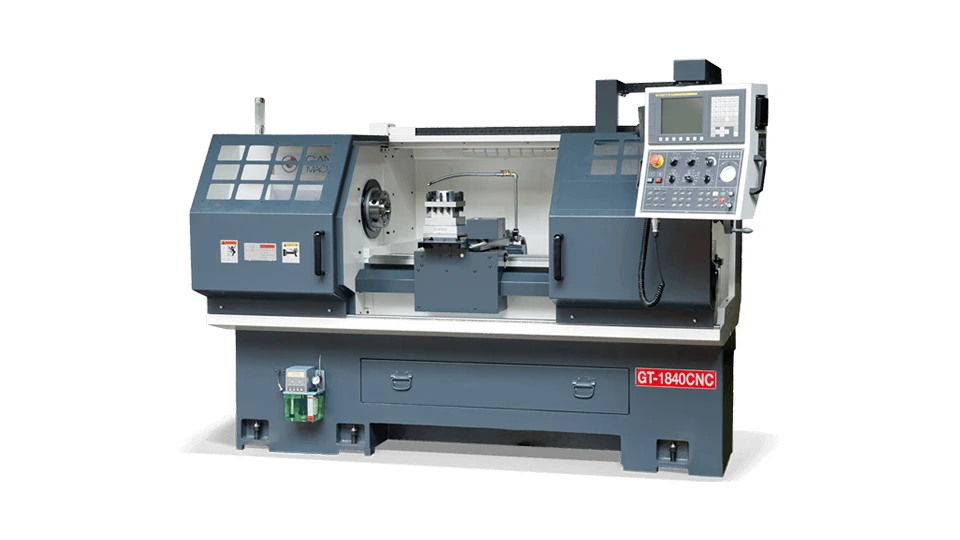
What is a Turning Center?
A turning center is an advanced type of CNC turning machine that builds upon the lathe’s core function by incorporating additional axes, live tooling, and higher levels of automation. These machines may include a Y-axis for off-center milling, a C-axis for spindle positioning, and sometimes a sub-spindle for secondary operations without manual part handling. Designed to complete multiple processes in one setup, turning centers excel in producing complex, high-precision parts for demanding industries such as aerospace, medical devices, and automotive manufacturing, where consistent accuracy and efficient throughput are essential.

Structural Differences
The structural design of CNC lathes and turning centers directly shapes their machining capabilities, precision levels, and operational flexibility. While both share the same fundamental turning principle, their mechanical layouts, tooling systems, and workholding configurations differ significantly. Understanding these differences is key when evaluating CNC Lathe vs Turning Center for specific production needs.
Axis Configuration
Most CNC lathes use a two-axis setup—X for crosswise tool movement and Z for longitudinal tool movement—making them ideal for simple, symmetrical turning operations. Turning centers, on the other hand, often integrate additional axes to handle more complex geometries. The Y-axis enables off-center milling and drilling, the C-axis allows the spindle to be indexed for contouring or drilling patterns, and in some advanced models, the B-axis permits angled tool approaches. These extra axes allow turning centers to complete multiple operations in one setup, reducing the need for repositioning and improving feature accuracy.
Flat Bed vs Slant Bed
Many entry-level CNC lathes feature a flat-bed design, where the bed is horizontal and the tool turret is aligned parallel to the floor. While cost-effective and easy to manufacture, this layout is less efficient at chip evacuation, which can lead to heat buildup and surface quality issues during long production runs. By contrast, most modern turning centers employ a slant-bed design—typically angled between 30° and 45°—that allows chips to fall away naturally under gravity. The slant bed also improves rigidity and vibration damping, which directly contributes to better surface finishes and dimensional stability. This design provides more clearance for tooling and is particularly advantageous for multi-axis and live-tooling operations, making it the standard choice for high-precision, multi-process machining.
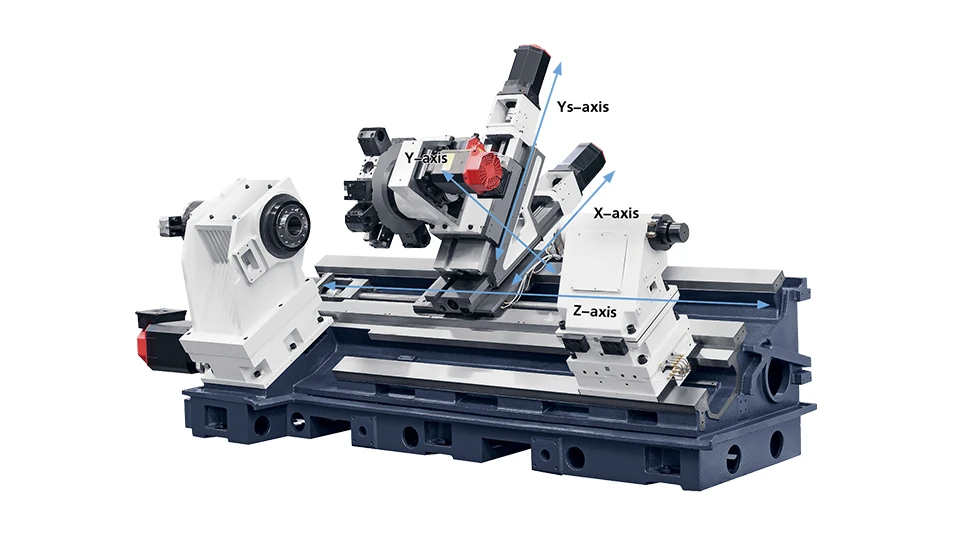
Tooling and Turret Systems
A typical CNC lathe is equipped with a fixed-tool turret, where each position is dedicated to a single turning tool. This setup works well for pure turning tasks but limits process variety. Turning centers, by comparison, often feature live tooling turrets that can perform powered milling, drilling, and tapping. These turrets may use BMT or VDI tool interfaces for enhanced rigidity and accuracy, and many are paired with Automatic Tool Changers (ATC) to expand tool capacity and minimize changeover time. This integration supports seamless transitions between turning and milling operations without removing the part from the machine.
Spindle and Workholding
Most CNC lathes have a single spindle, with a tailstock to support longer workpieces. This configuration is effective for straightforward turning but requires manual intervention for secondary operations. Turning centers frequently include dual spindles—a main spindle and a sub-spindle—allowing the machine to transfer the part automatically for back-side machining. This reduces setup time, eliminates re-chucking errors, and increases overall throughput. Workholding systems such as hydraulic chucks, quick-change jaws, and automatic clamping are more commonly integrated into turning centers, enabling faster, more reliable production cycles.
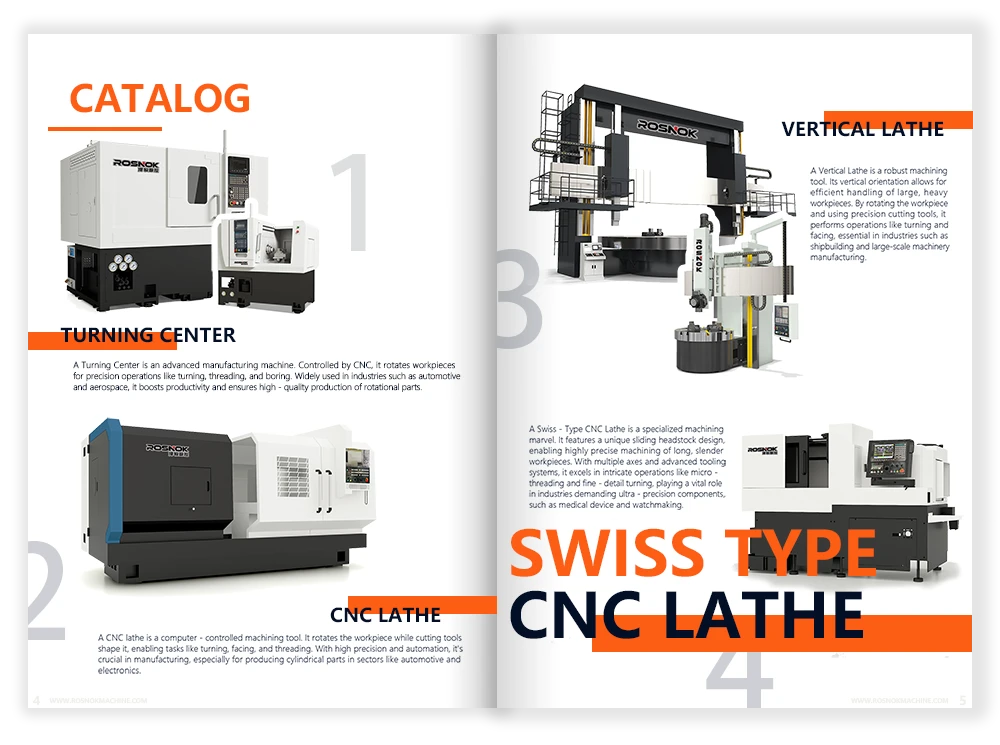
Working Principles
While CNC lathes and turning centers both operate on the same core turning principle—removing material from a rotating workpiece using a cutting tool—the way they execute machining tasks differs considerably. These differences stem from their axis configuration, tooling capabilities, and integration of multiple processes into a single setup. Understanding the working principles of each machine type is essential when comparing CNC Lathe vs Turning Center for a specific production workflow.
Turning Operations on CNC Lathes
In a CNC lathe, the primary motion is the rotation of the workpiece, driven by the main spindle. The cutting tool, mounted on a turret, moves along the X-axis to control diameter and the Z-axis to control length. This simple two-axis arrangement is ideal for producing external cylindrical surfaces, facing end surfaces, boring internal diameters, and cutting threads. The CNC control system precisely coordinates spindle speed, feed rate, and tool path to achieve accurate dimensions and surface finishes.
Because all operations are turning-based, tool changes are limited to different turning tools, and any additional processes like milling or drilling require moving the part to another machine. This makes CNC lathes highly efficient for producing large quantities of parts with consistent profiles and minimal variation.
Multi-tasking in Turning Centers
Turning centers expand on the basic turning principle by integrating additional motion capabilities and powered tooling. Live tooling enables the turret-mounted tools to rotate under their own power, allowing milling, drilling, tapping, and slotting operations without removing the workpiece from the chuck. The addition of a Y-axis enables off-center machining, while a C-axis allows the spindle to be indexed and synchronized with tool rotation for contour milling and hole patterns.
Some advanced turning centers feature a sub-spindle, enabling the machine to transfer the part automatically for back-side operations.By combining multiple processes in a single setup, turning centers reduce the number of machine changes, minimize cumulative setup errors, and improve overall precision. This multi-tasking capability is especially valuable for producing complex geometries and parts that require tight tolerance alignment between turned and milled features.
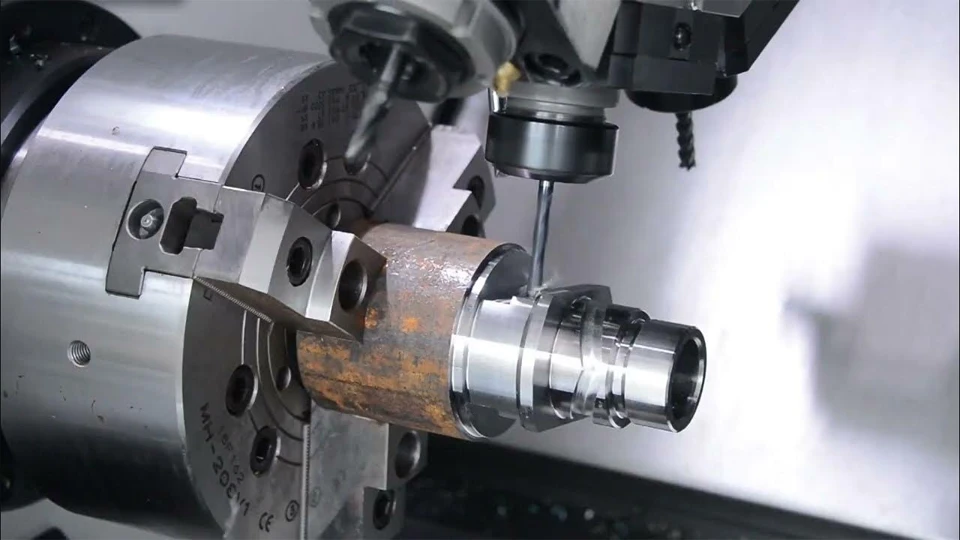
Machining Capabilities
Although CNC lathes and turning centers share the same basic turning process, their machining capabilities differ significantly in terms of part complexity, process flexibility, and production efficiency. These differences directly influence how each machine type is applied in modern manufacturing.
Part Complexity
A CNC lathe is best suited for manufacturing parts with simple rotational symmetry—such as shafts, bushings, and pulleys—where all features can be achieved with standard turning operations. Features like straight cylinders, tapers, grooves, and threads can be produced with high precision and repeatability. Its rigid structure, predictable cutting force direction, and fast turret indexing make it highly efficient in repetitive, high-volume production of such parts.However, when a part design includes off-center holes, milled flats, angled surfaces, or multiple intersecting geometries, a traditional CNC lathe would require multiple setups and additional machines to complete the job.
A turning center, in contrast, can handle complex part geometries in a single setup. With live tooling, a Y-axis, and spindle indexing via a C-axis, it can perform turning, milling, drilling, and tapping without removing the workpiece. This capability makes turning centers ideal for components with multi-faceted profiles, eccentric features, or intricate surface details, such as those found in aerospace fittings, hydraulic manifolds, or orthopedic implants. Because these operations are completed in one cycle, the CNC system must support precise synchronization and advanced toolpath programming to ensure feature alignment and surface quality.
Cycle Time and Productivity
CNC lathes excel in high-speed production of simple parts, where minimal tool changes and short cutting paths keep cycle times low. For example, in producing a batch of 500 identical flanges, a CNC lathe can deliver consistent results with short cycle times because every operation is optimized for turning alone. However, if the same part requires secondary operations like cross-drilling or slot milling, it would need to be transferred to a milling machine, adding setup time and potential alignment errors.
Turning centers eliminate this transfer by performing all required operations in one setup. This consolidation can cut total cycle time by 30–50% in complex parts. For instance, producing a hydraulic valve body that requires internal turning, multiple cross-holes, and milled flats could take two separate setups on different machines. On a turning center, the same part can be completed without removal, reducing handling, setup changes, and total production hours. In high-mix production environments, this multi-tasking capability translates into faster delivery, higher throughput, and more consistent quality.
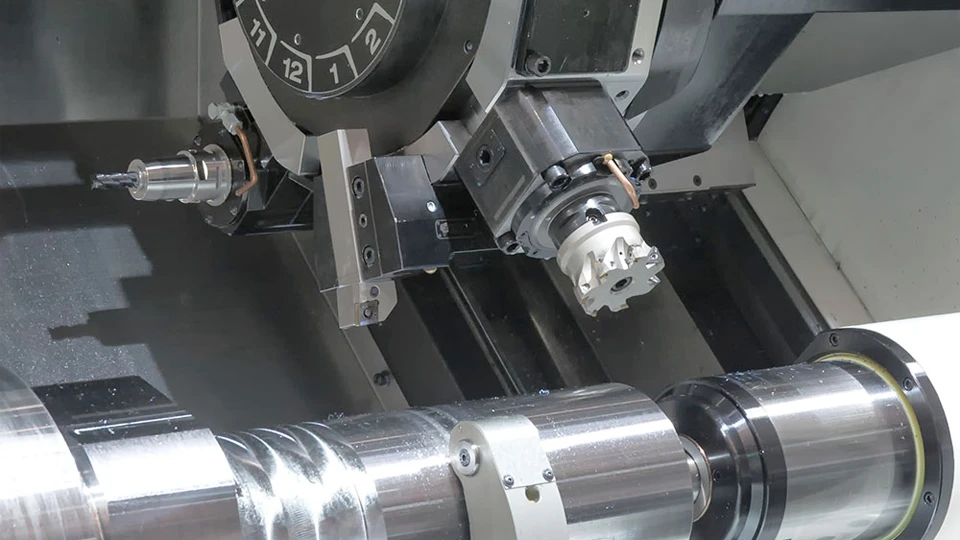
Accuracy and Precision
When comparing CNC Lathe vs Turning Center, accuracy is more than just a specification—it reflects how the machine’s design, rigidity, and process integration influence the final part quality. Both machine types can achieve tight tolerances when properly set up, but their strengths differ depending on the type of feature being machined.
Dimensional Accuracy
A CNC lathe is well known for its stability in producing highly accurate cylindrical and conical surfaces. The two-axis configuration and rigid structure mean that cutting forces are consistent and predictable, which helps maintain roundness, straightness, and concentricity within tight tolerances. In many applications, a CNC lathe can maintain dimensional variations within ±0.005 mm for standard turning tasks, making it ideal for parts where critical diameters and surface finish are the primary quality requirements.
Because the tool always approaches the workpiece from a consistent direction and the workpiece is supported throughout rotation, thermal expansion and deflection effects are minimized, ensuring repeatable accuracy across long production runs. This simple and stable configuration also makes CNC lathes particularly effective for shaft-type parts and high-volume production, where batch-to-batch consistency is a critical quality factor.
Complex Geometric Accuracy
Turning centers hold a clear advantage when machining complex geometries that require multiple operations. By completing turning, milling, and drilling in a single setup, they avoid the alignment errors that often occur when a part is moved between machines. Keeping the workpiece clamped throughout the process preserves the positional relationship between features, such as a milled flat relative to a turned diameter or a drilled hole pattern relative to a bore. In high-precision industries like aerospace and medical, geometric tolerances such as true position, profile, and angularity may be as tight as ±0.01 mm.
This level of accuracy is supported by synchronized multi-axis motion, high‑resolution feedback systems, and active thermal compensation. Effective error modeling within the CNC control further improves consistency when producing intricate part features. These capabilities define the suitability of CNC lathes and turning centers for different part designs and lead directly into the role of advanced control systems, which we will cover next.
Automation and Control Systems
The control system and level of automation directly influence how efficiently a CNC Lathe vs Turning Center can produce parts. While both machines rely on CNC technology to execute precise tool paths, their control features and automation options differ significantly.
CNC Control Features
Both CNC lathes and turning centers use G‑code programming as the foundation for defining tool movements, spindle speeds, and feed rates. On a standard CNC lathe, the programming is typically limited to turning operations along the X and Z axes. Macro programming may be available, but it is mainly used for repetitive turning cycles or minor customization of programs. Tool compensation is straightforward, usually covering wear and geometry offsets for a limited number of tools.
Turning centers require a more capable control system because they manage multiple operations in one setup. In addition to standard turning codes, the control must coordinate live tooling, Y‑axis interpolation, and spindle indexing for milling or drilling operations. Macro programming is often used to handle complex toolpath logic, subprogram calls, and conditional operations. Tool compensation becomes more advanced, covering not only turning tools but also milling cutters and drills, each with different wear patterns. High‑end turning centers may also support real‑time spindle synchronization and polygon turning cycles, further expanding their process flexibility.
Automation Level
Most CNC lathes use a tool post that can index between a limited number of fixed turning tools. This setup is effective for pure turning operations but does not support live tooling. As a result, any milling, drilling, or tapping operations must be carried out on another machine equipped for those processes.
Turning centers typically employ a servo‑driven or live‑tool turret, which can hold multiple static and powered toolholders. With the addition of live tooling, the same machine can perform turning, milling, drilling, and tapping in a single setup. Tool changes are faster, and the tooling configuration is far more versatile. Many turning centers also integrate with robotic arms or gantry loaders for automated loading and unloading, enabling lights‑out manufacturing and reducing idle time in both high‑volume and high‑mix production environments.

Application Scenarios
The choice between a CNC Lathe vs Turning Center is often determined by the type of parts, production volume, and required operations. Each machine has clear strengths in specific industries and component types.
CNC Lathes in Production
CNC lathes are widely used in high‑volume production of rotationally symmetrical parts with relatively simple geometries. In the automotive industry, they are commonly employed to produce transmission shafts, brake drums, hubs, and flanges. Their ability to maintain consistent dimensional accuracy over long production runs makes them ideal for such components.
In the oil and gas sector, CNC lathes are used for couplings, sleeves, and threaded connectors where robust material removal and reliable threading performance are required. Standard tool posts with fixed tooling handle these tasks efficiently, especially when the focus is on external and internal turning, facing, grooving, and threading. By keeping the process limited to turning operations, cycle times remain predictable and setup complexity is minimized, supporting cost‑effective mass production.
Turning Centers in Production
Turning centers are best suited for parts that combine turning features with additional machining operations such as milling, drilling, or tapping, and benefit from being completed in a single setup. In aerospace manufacturing, they are often used for components like landing gear sleeves, bearing housings, and structural coupling rings. These parts require both high‑precision turned diameters and machined features such as keyways, bolt holes, or milled flats. Live tooling and Y‑axis capability make it possible to add these features without removing the part from the chuck, preserving positional accuracy.
In the energy sector, turning centers are commonly applied to valve bodies, pump shafts, and turbine hubs. These parts demand accurate concentricity between bores and external profiles, as well as secondary features like flange bolt patterns or sealing grooves, which can be machined directly on the same machine.
In medical technology, turning centers are used for cylindrical surgical tools, orthopedic screw blanks, and implant components that require both turned surfaces and cross‑drilled or slotted features. While ultra‑small or highly intricate micro‑geometry work may be better suited to Swiss‑type lathes, turning centers handle medium‑ to large‑sized medical parts with excellent accuracy and reduced handling time.
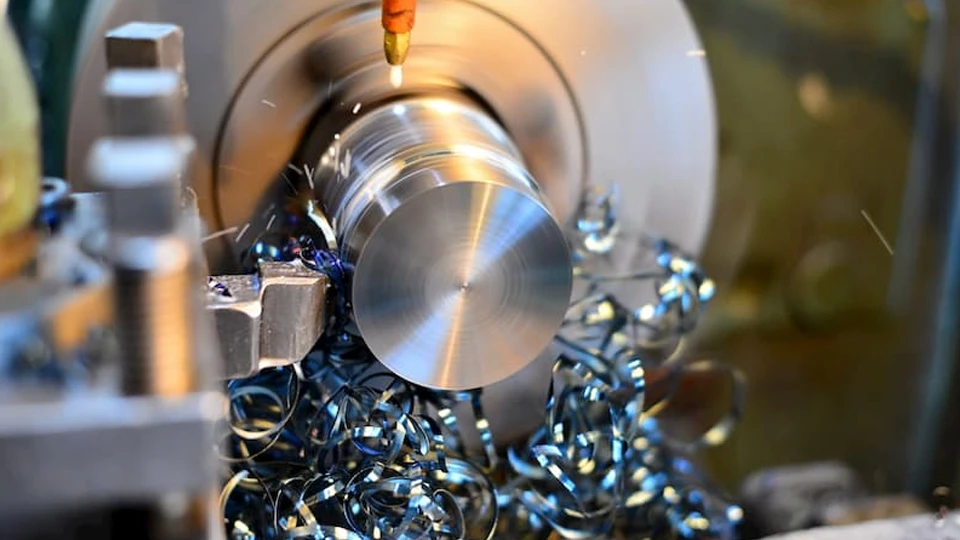
Cost, ROI, and Maintenance
The financial and operational considerations of a CNC Lathe vs Turning Center often influence the final purchasing decision as much as technical capability. While both machines can deliver precision results, their cost structures and maintenance demands are notably different.
Initial Investment and Operating Costs
A standard CNC lathe generally requires a lower initial investment compared to a turning center. The simpler design, fewer axes, and lack of live tooling make it less expensive to purchase and install. Operating costs are also lower, with reduced energy consumption and fewer wear components. For high‑volume production of simpler parts, this can yield a faster return on investment (ROI).
Turning centers, by contrast, command a higher purchase price due to their multi‑axis capability, live tooling systems, and more sophisticated CNC controls. However, their ability to consolidate multiple operations into one setup can reduce labor costs, shorten lead times, and improve part quality by eliminating multiple setups. Over time, these benefits can offset the higher initial expenditure, especially in industries producing complex, high‑value components.
Maintenance Considerations
CNC lathes, with their straightforward mechanical layout and limited moving parts, tend to have longer intervals between major maintenance tasks. Routine servicing typically involves lubrication, alignment checks, and periodic replacement of consumables such as belts or coolant filters.
Turning centers require more intensive maintenance due to their greater mechanical and control complexity. The presence of live tooling, additional axes, and advanced automation systems means more components to inspect, calibrate, and replace over the machine’s life. Turret indexing mechanisms, Y‑axis slides, and spindle synchronization systems require regular precision checks to maintain accuracy. This results in higher maintenance costs and potentially longer service downtimes, but is often justified by the machine’s expanded capability and production flexibility.
How to Choose Between CNC Lathe and Turning Center
Selecting between a CNC Lathe vs Turning Center requires a clear understanding of production goals, part specifications, and long‑term operational needs. The right choice can maximize productivity and return on investment, while the wrong choice can lead to under‑utilized equipment or process bottlenecks.
Decision Factors
Part geometry and features – If parts are primarily cylindrical with straightforward turning operations, a CNC lathe is usually sufficient. If parts require additional features such as milled flats, keyways, or drilled holes aligned to turned surfaces, a turning center’s live tooling and Y‑axis capability become valuable.
Production volume – For high‑volume runs of simple parts, CNC lathes often deliver the lowest cost per unit due to shorter cycle times and simpler setups. Turning centers show their advantage in mixed‑production environments, where the ability to handle different part designs without changing machines saves time.
Budget and ROI – CNC lathes have a lower initial cost and simpler maintenance requirements, making them a practical choice for businesses with limited budgets or narrow part ranges. Turning centers require a higher investment but can deliver greater long‑term returns in environments producing complex, high‑value parts.
Future expansion – Consider whether product designs are likely to evolve. If there is a possibility of needing multi‑operation capability in the future, investing in a turning center can avoid the need for another machine purchase later.
Common Mistakes to Avoid
Over‑specifying equipment – Purchasing a turning center for parts that only require basic turning can result in unnecessary costs and longer setup times. Match machine capabilities to actual part requirements.
Underestimating cycle time impact – Choosing a CNC lathe for parts that require multiple secondary operations can lead to excessive handling and setup time, which increases total cost per part.
Ignoring operator skill requirements – Turning centers with multi‑axis controls and live tooling demand higher programming and setup skills. Ensure your team has, or can be trained in, the required expertise before purchasing.
Not considering maintenance complexity – A turning center’s additional axes and tooling systems require more regular precision checks and servicing. Failure to account for these needs can result in unexpected downtime and higher ownership costs.
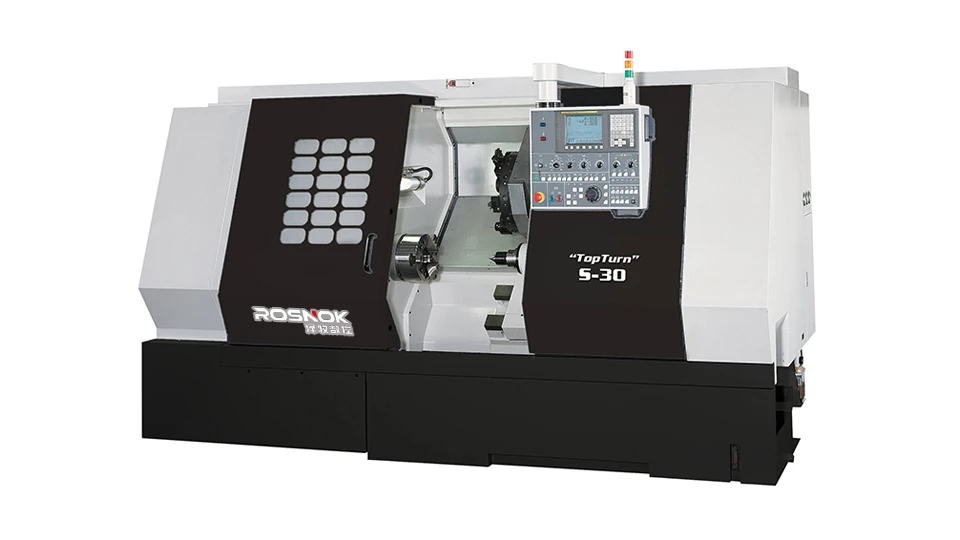
Conclusion
The comparison of a CNC Lathe vs Turning Center comes down to differences in structure, capability, and intended use. A CNC lathe is built around a straightforward two‑axis design for efficient turning of cylindrical parts with high repeatability, making it ideal for simpler geometries and high‑volume production. A turning center expands on this foundation with additional axes, live tooling, and automation features that allow turning, milling, drilling, and tapping in a single setup—reducing handling, improving geometric accuracy, and enabling the production of complex, multi‑feature components.
For manufacturers seeking equipment that balances precision engineering with long‑term reliability, working with a builder experienced in both CNC lathes and turning centers can be decisive. At Rosnok, decades of expertise in designing and producing advanced CNC machine tools—ranging from high‑performance lathes to fully‑equipped turning centers—allow us to provide solutions tailored to each customer’s workflow. Whether the priority is high‑volume production, complex part machining, or a flexible mix of both, our machines are built to deliver accuracy, productivity, and lasting value in demanding industrial environments.

